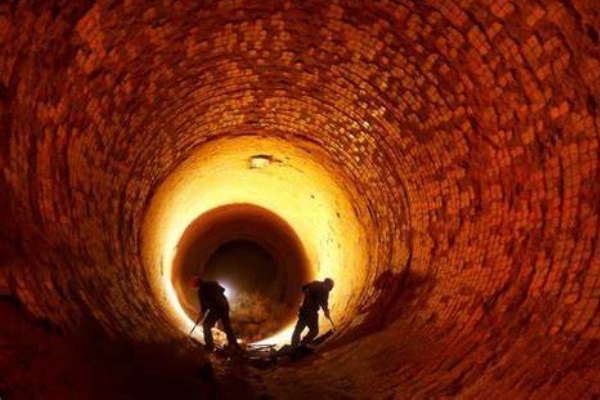
이런 이유로 그들은 또한 내화성 벽돌의 열 화학적 안정성을 줄입니다.. 곡물 경계 용융 형성에서 작용할 때 특히 그렇습니다. (예를 들어. Fe203 등).
고순도, 낮은 다공성, 굵은 마그네시아는 특수 마그네슘 내화 벽돌 생산의 원료입니다.. 마그네사이트의 입자 성장을 촉진하기 위해, 소량을 추가하는 방법 (미만 0.5%) CR203, Fe203, ZrO2, V의 산화물 및 염뿐만 아니라, MN, A1, Cu, 그리고 희토류 요소는 과거에 사용되었습니다. 이러한 물질은 다른 메커니즘에 의해 MGO 밀도 및 곡물 성장을 촉진하지만. 하지만, 그것들은 모두 가속 확산을 사용하여 달성됩니다.
이런 이유로 그들은 또한 내화성 벽돌의 열 화학적 안정성을 줄입니다.. 곡물 경계 용융 형성에서 작용할 때 특히 그렇습니다. (예를 들어. Fe203 등). 이것은 마그네슘 내화 벽돌의 열 화학적 안정성을 감소시키지 않으면, 내부에 다른 이물질을 추가하는 것은 피해야합니다..
외래 물질이 첨가되지 않은 경우, 기술적 인 조치는 사용하는 것입니다 500 수산화 마그네슘 또는 마그네사이트의 900 ℃ 전처리의 전처리, 이어서 반응성 MGO 물질의 처리 (미세한 연삭). 특수 마그네시아는 볼링/연탄 전에 불활성 MGO 종을 추가하거나 첨가하여 생산됩니다., 그런 다음 고압 공/연탄 및 나중에 고온 가마에서 소결.
이러한 모든 기술적 조치는 결정화를 방지하는 다공성을 줄입니다., 밀도를 향상 시키십시오, 소결 가속기가 없을 때, 또한 마그네 사이트 곡물의 성장으로 이어집니다. 이것이 로타리 가마에서 이루어지면, 그런 다음 온도가 상한 경우에도 (1900 2000 ° C까지) 도달합니다. 그리고 시간을 연장합니다. 소성의 강도를 높이기 위해. 특별한 조치가없는 경우. 이것은 곡물 직경이 약 50 ~ 120μm 인 마그네슘 모래 만 얻을 수 있습니다.. 더 큰 마그네슘 모래 알갱이를 얻어야한다면. 그런 다음 큰 곡물 소결 마그네슘 모래 데드 발사 Kiln의 생산을 위해 수직 가마를 사용해야합니다..
수직 가마의 죽은 발사 온도는 산소 농축 상태가없는 상태에서도 2100 ~ 2300에 도달 할 수 있습니다.. 이로 인해 저온 정리 마그네시아의 평균 사각 마그네이트 곡물 직경이 2001lm 이상에 도달 할 수 있습니다..
위의 마그네시아를 생성하는 고온 수직 가마의 소결 벨트를 감싸는 내화 된 벽돌은 만족해야합니다. (1) 고순도 마그네시아에 대한 오염이 없습니다, 그리고 (2) 2100 ~ 2300의 운영 조건에 적응할 수 있어야합니다.. 그러므로, 소결 벨트를 건설하려면 고급 스페셜 마그네슘 내화 벽돌을 선택해야합니다..
이 마그네슘 내화 벽돌은 일반적으로 원료 생산으로 선택됩니다. 99% MGO의 순도, 3.40g/cm3 이상의 벌크 밀도 거친 곡물 마그네슘 모래. 성능 지표 MgO ~이다 98% ~ 99%.
3.0g/cm3 pa ≤의 내화 벽돌 밀도 17%, t ℃ ≥ 1800 ℃. 다른 부분 (전 배대 밴드 및 냉각 밴드) 선택된 MGO 컨텐츠입니다 97.5 % ~ 98% 고순도 마그네슘 벽돌 벽돌.
고온 내화 벽돌 벽돌 방법은 많습니다, 그리고 그들은 가마 벽돌의 품질에 큰 영향을 미칩니다., 일반적으로 평가해야 할 다음 요구 사항 중 일부를 통해.
1. 운영 안전
2. 정확하고 숙련 된 설치
3. 벽돌공 시간
4. 벽돌공 장비 취급 (유연성).
1. 습식 레이어링 방법은 주로 점토 벽돌에 사용됩니다., 그리고 높은 알루미나 벽돌 2. 젖은 레이어링 방법, 고온 내화 벽돌, 내화성 진흙 굴절은 비교적 가깝습니다, 그렇지 않으면, 실행됩니다, 가마 벽돌은 착용하지 않았습니다, 그러나 내화 진흙은 더 이상 아닙니다, 따라서 벽돌을 떨어 뜨리는 것은 쉽습니다. 내화 점토는 고르게 적용되어야합니다.
2. 드라이 레이어링 방법은 주로 백운석 벽돌과 마그네슘 크롬 벽돌에 사용됩니다., 주로이 두 종류의 벽돌은 물에 취약하기 때문에 품질에 영향을 미칩니다..
1. 현재, 세로 스 태거 석조 방법은 덜 사용됩니다, 학교의 전반적인 강점보다 낫지 만, 서로 더 밀접하게 연결되어 있습니다, 문제가 발생할 때, 더 작은 파괴 지점은 더 큰 표면 손상의 결과 일 수 있습니다..
2. 수평 링 벽돌 벽돌은 인접한 벽돌 원형 벽돌 솔기로 직선으로 나뉘어져 두 개의 벽돌이 엇갈리게됩니다.. 벽돌 이음새는 직선입니다, 벽돌 크기 편차 또는 벽돌공으로 인해., 비틀 거리는 벽돌 서클, 벽돌 구석은 부러지기 쉽고 힘이 나빠질 수 있습니다..
1. 현재, 로타리 방법은 일부 작은 가마에만 사용됩니다., 큰 가마의 경우, 가마를지지하면 가마 쉘을 변형시킬 때 큰 압력이 있습니다.. 가마 지원은 부피가 커집니다, 지원 처리가 편리하지 않습니다, 가마의 직경이 클수록, 힘을 견딜 수있는 가마 지지대는 더 커질 것입니다, 쉬운 위험, 벽돌공 속도는 비교적 느립니다.
2. 접착 방법, 보조 도구가 필요하지 않습니다, 벽돌공 속도. 그러나 접착제 방법은 주로 가마 벽돌의 품질을 보장하기가 어렵습니다., 벽돌공 원이 견고한 지 여부를 결정할 방법이 없습니다.. 벽돌의 끝을 위해, 불균일은 다루기가 어렵습니다. 가마가 매우 깨끗해야하기 전에 벽돌이 눕습니다., 그렇지 않으면, 접착제 결합의 영향에 영향을 미칩니다.
3. 고정 방법 가마 쉘의 하반부가 수동으로 놓여 있습니다., 그리고 원의 상단 절반은 벽돌공 기계로 고정되어 있습니다.. 고온 내화 벽돌은 파이어 브릭을 놓습니다, 그리고 벽돌은 가마 섹션의 어느 곳에서나 놓을 수 있습니다., 벽돌공 기계는 가마로 이동하기에 매우 편리합니다.. 벽돌공이 빠릅니다, 효율적인, 그리고 안전합니다.
내화 당은 가벼운 열 감동 벽돌 시리즈를 포함하여 광범위한 제품을 생산합니다., 점토 벽돌, 높은 알루미나 벽돌, 마그네슘 벽돌, 산재성, 알칼리성, 그리고 낮은 크리프 시리즈 벽돌, 중립 다루기 힘든 시리즈, 및 다양한 고온 특수 내화물. 우리의 제품은 야금에 선호되는 내화 제품입니다, 유리 가마, 세라믹 가마, 비철 금속 제품, 석유화학 제품, 내화 재료 및 기타 산업.
10월부터, 알루미나 가격은 지속적으로 상승, and China's largest bauxite importer - a…
첫 번째, 고알루미나 벽돌: The Leader In High Temperature Refractories As a leader in high-temperature…
The application of refractory bricks in the kiln immediately endangers the operation rate of the…
Analysis Of The Causes Of Common Quality Problems In Tunnel Kiln Construction And Measures To…
Corundum quality refractory castables are made from corundum to the new jade refractory insulation material…